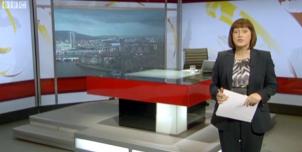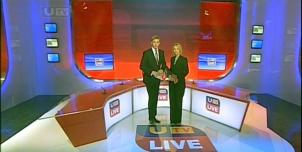Full Freeview on the Limavady (Northern Ireland) transmitter
| Google Streetview | Google map | Bing map | Google Earth | 55.108,-6.887 or 55°6'30"N 6°53'14"W | BT49 9LJ |
The symbol shows the location of the Limavady (Northern Ireland) transmitter which serves 45,000 homes. The bright green areas shown where the signal from this transmitter is strong, dark green areas are poorer signals. Those parts shown in yellow may have interference on the same frequency from other masts.
This transmitter has no current reported problems
The BBC and Digital UK report there are no faults or engineering work on the Limavady (Northern Ireland) transmitter._______
Digital television services are broadcast on a multiplexes (or Mux) where many stations occupy a single broadcast frequency, as shown below.
64QAM 8K 3/4 27.1Mb/s DVB-T MPEG2
H/V: aerial position (horizontal or vertical)
The Limavady (Northern Ireland) mast is a public service broadcasting (PSB) transmitter, it does not provide these commercial (COM) channels: .
If you want to watch these channels, your aerial must point to one of the 80 Full service Freeview transmitters. For more information see the will there ever be more services on the Freeview Light transmitters? page.
Which Freeview channels does the Limavady transmitter broadcast?
If you have any kind of Freeview fault, follow this Freeview reset procedure first.Digital television services are broadcast on a multiplexes (or Mux) where many stations occupy a single broadcast frequency, as shown below.
64QAM 8K 3/4 27.1Mb/s DVB-T MPEG2
H/V: aerial position (horizontal or vertical)
The Limavady (Northern Ireland) mast is a public service broadcasting (PSB) transmitter, it does not provide these commercial (COM) channels: .
If you want to watch these channels, your aerial must point to one of the 80 Full service Freeview transmitters. For more information see the will there ever be more services on the Freeview Light transmitters? page.
Which BBC and ITV regional news can I watch from the Limavady transmitter?

BBC Newsline 0.6m homes 2.5%
from Belfast BT2 8HQ, 1,051km northeast (51°)
to BBC Northern Ireland region - 46 masts.
Are there any self-help relays?
| Elliotts Hill | Transposer | 13 km SE Ballymena, Co. Antrim | 90 homes (according to B9 Energy) |
How will the Limavady (Northern Ireland) transmission frequencies change over time?
| 1984-97 | 1997-98 | 1998-2012 | 2012-13 | 4 Sep 2019 | |||||
| C/D E | C/D E | C/D E | C/D E T | B E K T | |||||
| C40 | SDN | ||||||||
| C41 | BBCA | ||||||||
| C43 | ArqA | ||||||||
| C44 | D3+4 | ||||||||
| C46 | ArqB | ||||||||
| C47 | BBCB | ||||||||
| C48 | _local | _local | |||||||
| C49tv_off | ArqB | ||||||||
| C50tv_off | BBCA | ||||||||
| C54tv_off | SDN | ||||||||
| C55tv_off | BBC1waves | BBC1waves | BBC1waves | BBCB | |||||
| C58tv_off | ArqA | ||||||||
| C59tv_off | ITVwaves | ITVwaves | ITVwaves | D3+4 | |||||
| C62 | BBC2waves | BBC2waves | BBC2waves | ||||||
| C65 | C4waves | C4waves | C4waves |
tv_off Being removed from Freeview (for 5G use) after November 2020 / June 2022 - more
Table shows multiplexes names see this article;
green background for transmission frequencies
Notes: + and - denote 166kHz offset; aerial group are shown as A B C/D E K W T
waves denotes analogue; digital switchover was 10 Oct 12 and 24 Oct 12.
How do the old analogue and currrent digital signal levels compare?
| Analogue 1-4 | 100kW | |
| BBCA, D3+4, BBCB | (-7dB) 20kW | |
| SDN, ARQA, ARQB | (-10dB) 10kW | |
| Mux 1*, Mux 2*, Mux A*, Mux B*, Mux C*, Mux D* | (-21dB) 800W |
Local transmitter maps
Limavady Freeview Limavady DAB Limavady AM/FM Limavady TV region BBC Northern Ireland UTVWhich companies have run the Channel 3 services in the Limavady transmitter area
|
|
Friday, 26 October 2012
seamus o'doherty: If the ground was flat and a transmitter radiated the same level of signal in all directions (omnidirectional), then the coverage area would be a circle. However, the ground isn't flat and the terrain prevents reception.
Imagine if the signal were light, which isn't too dissimilar as they are both electromagnetic waves. An obstruction like a tree or a building creates a shadow and the same is true of the terrain.
The coverage map takes into account the terrain and shows green where the signal is expected to be available at rooftop height (above the ground).
Look at the map at imagine a line between Limavady and Strabane town. Along that line, the coverage stops roughly at the top of the "/" in the place name "Londonderry / Derry".
Referring to a map with contours it is easy to see why this is the case:
NIEA Map Viewer
Loughmore is very high ground and therefore blocks reception!
Theoretically, if you (in Strabane) were to go high enough to "see" over the obstruction, or at least high enough to where there is a bit of signal, then you would be able to receive from Limavady.
Thus, the signal is there, it's just way above you. The coverage map shows what you're interested in which is reception at roof-top level and not many tens or hundreds of metres above the ground.
| link to this comment |
Tuesday, 30 October 2012
B
Brendan12:11 AM
Hi, do you know if the sdn, arqa and arqb muxes will be boosted or will it remain at 10kw, I am currently receiving the other freeview muxes perfectly but not the ones on lower power, I live in Letterkenny in Donegal
| link to this comment |
Brendan: All multiplexes are at their final power levels.
| link to this comment |
Brendan: Quite a few transmitters that carry the Commercial (COM) channels have them at lower power than the Public Service (PSB) ones (usually half-power).
| link to this comment |
B
Brendan Waters 11:47 PM
Hi, thanks for your replys, I have since retuned my tv again and I am now getting every channel but not the Film4 etc mux, is there technical reason why this might be happening, I am using a grid type aerial pointed towards limavady transmitter. Thanks. Brendan
| link to this comment |
Wednesday, 31 October 2012
I
Ian Drury7:28 PM
I live in Donegal, and had perfect reception since last Wednesday, 24th, but since last night BBCB on ch 55 has disapppeared, the HD channels. The rest are perfect. What happened between Monday and Tuesday? (54.90831,-7.67339)
| link to this comment |
Ian Drury: Fanad broadcasts on C55, albeit vertically.
| link to this comment |
Thursday, 1 November 2012
I
Ian Drury9:47 AM
I know, but I was receiving BBCB Mux ch 55 from Limavady perfectly for six days, then nothing, how is that explained? (54.90831,-7.67339)
| link to this comment |
Ian Drury: Digital pictures are an all or nothing sort of thing. There is very little inbetween where they break up a bit. It is said that there is a "cliff edge" over which the picture can't be resolved.
If it is interference, for example from Fanad, then it could have been that, previously, whilst the picture was "perfect", the signal was being interfered with, but not to the degree to push you off the cliff.
What this means is that there is only a "slight" change to the level of degradation required to move from "only just" being good enough (which produces a "perfect" picture) to "only just" being not good enough (which produces no picture).
Such a change could have come about due to a change in the Fanad signal (if that is what is the cause) and this may be something that has moved and is causing a reflection in your direction. Or perhaps there was something that was acting to block or reduce the signal from Fanad that has now moved. Or maybe something has acted to reduce the signal from Limavady.
I mentioned that Fanad is co-channel simply as an observation. If you could receive analogue from Fanad (to some degree, even if not watchable, and particularly so on your Limavady aerial), then this might perhaps add weight to its digital signal being a possible cause of your woes.
| link to this comment |
Ian Drury: Should it prove to be interference from Fanad and you have a grid aerial, such as that shown in this picture, then perhaps a more directional aerial will be better:
Aerials, TV Aerial and Digital Aerial
Grid aerials have a wide acceptance angle and therefore less gain than more directional ones. This is because to get more gain, the aerial simply focuses on a narrower "beam".
Both Holywell Hill and Limavady are on similar bearings and a grid aerial with its wider acceptance angle would therefore be perfect for such an application. However, its wider acceptance angle leaves it open to picking up interference that a more directional antenna would be likely to "reject".
Obviously if the interference is eminating from the direction of the transmitter, then a more directional aerial will still pick it up.
| link to this comment |
Select more comments
Your comment please!





